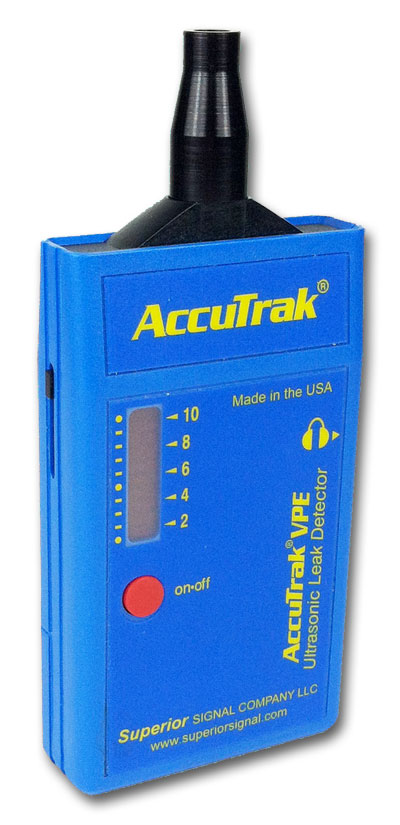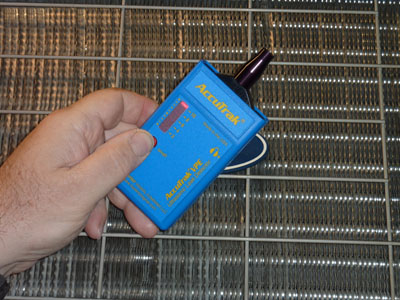Ultrasonic Leak Detectors; A Sound Choice
By Richard Luhm, and Paul Tashian The idea of detecting refrigerant leaks by ultrasound, to you may have seemed a bit far fetched. "Really, how well could it possibly work?" - you may have asked yourself. "I've tried every type of detector there is, and none of them really do the job!", or "I already own three leak detectors, why do I need another one?". Can you hear yourself voicing these very words?
The idea of detecting refrigerant leaks by ultrasound, to you may have seemed a bit far fetched. "Really, how well could it possibly work?" - you may have asked yourself. "I've tried every type of detector there is, and none of them really do the job!", or "I already own three leak detectors, why do I need another one?". Can you hear yourself voicing these very words?
While manufacturers of leak detection products would like you to believe that theirs is the best and only method that should be used, the truth is, no one leak detection technique is guaranteed to find every leak, every time, in all situations. For the modern contractor to be as successful as he can be, he must open his mind to the latest technologies, and know how and when they can most effectively be utilized. A good ultrasonic leak detector can locate a leak that could not be found with any other technique.
Ultrasonics, as the name implies, is sound above the detection range of the human ear. Imagine the sound air makes as it leaks from a tire. The sonic sound (that which your ear CAN detect) is only about a third of the actual spectrum of sound that the leak produces. That which remains is ultrasonic. With smaller leaks, such as the ones you will be searching for, high frequency ultrasound is emitted before any sonic sound can be detected.
The key to success in finding a leak with sound, depends on whether the leak is turbulent. Turbulence is generated by the friction and collision of gas molecules as they are forced from an area of higher pressure to an area of lower pressure. This is the case with leaks in pressurized refrigerant systems, or vacuum situations as well.
Example: A 1 inch pipe attached to a 3 psi air supply will not generate the turbulent flow necessary to be detected with an ultrasonic detector, however, by sealing the end of the pipe leaving a pinhole (.004 in) orifice, it could be detected several feet away.
In this example it is actually a smaller leak that creates more sound. This is why ultrasonic detectors can not state their sensitivity in terms of oz. per year. In general leaks as small as .5 oz. a year can only be found under laboratory conditions. At a leak rate this slow it would take approximately 32 years to lose 1 pound of refrigerant. It is unlikely that you would be called to service a system leaking this slowly.
Many factors will affect the amount of turbulence (therefore sound), emitted from a leak. Not just the size of the orifice (leak), but the shape of the leak, and the pressure behind it. Whistling is a good example, changing the shape of your mouth, and blowing harder will create different sounds.
 A good ultrasonic leak detector will translate the high frequency ultrasound down to a lower frequency which your ear can interpret. This has several advantages when it comes to refrigerant leak detection. First, It does not matter what refrigerant is being used in the system. All pressurized gasses, if turbulent, will generate ultrasound when they leak (new refrigerants as easily as the old).
A good ultrasonic leak detector will translate the high frequency ultrasound down to a lower frequency which your ear can interpret. This has several advantages when it comes to refrigerant leak detection. First, It does not matter what refrigerant is being used in the system. All pressurized gasses, if turbulent, will generate ultrasound when they leak (new refrigerants as easily as the old).
Ultrasonic detectors are versatile instruments. During the recovery process, an ultrasonic leak detector can hear the sound of a vacuum leak, as air rushes into the system. If you can't achieve a deep enough vacuum, why not do a quick leak test? Ultrasonics is the only method that can detect pressure and vacuum leaks at the same time. Additionally, some contractors have even found ultrasonic leak detectors to be an effective way to locate air leaks in pressurized ductwork.
Richard Luhm, owner of Richards & Associates Commercial Refrigeration in Memphis TN., finds the ultrasonic very valuable to his business.
" I work mostly with supermarket refrigeration units that still contain lots of CFC's. These refrigerants along with all the replacement refrigerants are very costly and have forced contractors such as myself to become very innovative in their efforts to contain refrigerant leaks. Air movement from surrounding units often cause leaks to be detected far from their actual source, or not detected at all. This becomes increasingly frustrating when time is at such a premium. I have to find leaks and repair them as quickly as possible. My reputation is built on quality, and fixing the problem the first time. As a result of this commitment, I check out every means possible to help me in this endeavor. The ultrasonic has greatly reduced the problem of air movement in leak detection. It has also been a marvelous tool for locating door gasket leaks in walk-ins and even noting the flow and modulation of all types of refrigeration valves including expansion valves."
Contaminants, or high concentrations of gas in the test area can be a problem with traditional methods of leak detection, says Mr. Luhm...
" I have lots of parallel systems in stores I service. Loss of refrigerant can be in extreme measures when there is anywhere from 600lbs. to 2500lbs. of refrigerant in the system. With over 5000 welds, fittings, and screw type connections on a typical rack, the odds of multiple leaks are enormous. Even with one of the best "sniffer" type detectors with an air pump, the large amount of refrigerant in the air, coupled with the close proximity of all the sources of leaks, makes it quite impossible to narrow the leak down to one specific spot, or sometimes, even a general area. Cracks are caused by hot gas at high pressure banging on copper pipes for years. These cracks are exceptionally hard to locate, unless you happen to literally feel the refrigerant blowing out of the crack. With an ultrasonic detector, however, this problem has been 'blown away'. After purchasing my ultrasonic detector, I went straight to a store that had lost some 800lbs of refrigerant over a 90 day period. The equipment room was so full of refrigerant I couldn't even enter the room without my "sniffer" going crazy. I put on the headphones of the ultrasonic and heard the leak from six feet away! It took me directly to the source within 30 seconds! I definitely recommend an ultrasonic detector for every technician's arsenal of leak detection paraphernalia."
With an instrument so sensitive to sound, you might think that background noise would be a major problem. Most air conditioning applications do not create enough ultrasonic background noise to affect modern ultrasonic detectors. An extremely loud parallel refrigeration system involving several compressors and a multitude of pressure regulating valves would be difficult to test while it was operating because the flow through the valves will sound similar to a leak. For best results shut the system down and wait a few minutes for it to equalize.
Trying to hear a leak in a noisy environment is like trying to have a conversation at a concert. The closer you are to the source of the background noise, (speakers) the harder it will be to hear. The advantage to ultrasonic sound is that it is much more directional than sonic sound. By turning the sensor away from the source of background noise, and toward the leak, most of the background interference can be ignored.
Ultrasonic leak detectors have proven to be more effective in situations where other methods were not. So remember, when choosing a leak detector always consider the situation, and the factors which may affect the performance of a specific type of leak detector? Choose the instrument best suited for the specific job at hand. It may very well be an Ultrasonic leak detector.

